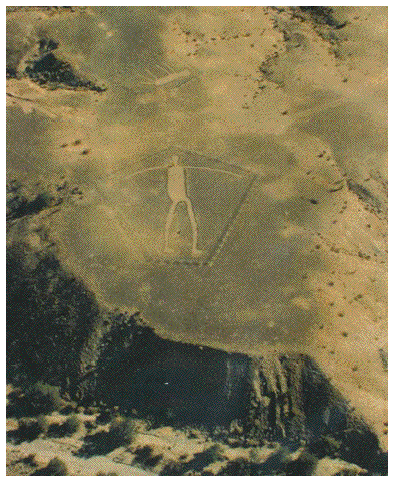GEOGLYPHS: YUMA
|
|
|
Geoglyphs
are found on the ground along the Colorado River near Blythe, Riverside County, California. They are made by scraping away the dark colored pebbles from the surface of the ground. This figure may represent the mythological ancestor of the Yuma Indians. The figures are made where events in the myth are supposed to have taken place. It is 175 feet long. In the background of the photograph is another figure. It is of a four legged animal. Maybe it is Coyote, another figure in the Yuman creation myth.
Edited image from original photograph by D. McCarthy.
|
GEOGLYPHS: YUMA
ROCK ART SITES
|
Corn Spring.
contact: B.L.M. Palm Springs Field Office, Palm Springs, CA
|
The Blythe Geoglyph.
near Blythe, CA, off Hwy 95. contact: B.L.M. Palm Springs Field Office, Palm Springs, CA
|
The Yuma were a large tribe in the days before European contact. They, and their neighbors the Mojave, lived along the Colorado River and cultivated garden plots on the flood plains. They are regarded the western most of the southwestern farming peoples which include the Hopi, Pima, Maricopa, Zuni, and Havasupai tribes currently living in Arizona. The Yuma culture seems to be a transition between that of the southwestern farming people and the cultures of the other California people.
Houses were rectangular, 20 to 25 feet wide. The door was on the south. Large posts supported a thatch roof, which was covered with earth. Because the houses were constructed over a two to three foot deep pit, and insulated by the earth-covered roof, they were cool in the summer heat.
The Yuma made pottery. They caught fish in the Colorado River and hunted land mammals. They cultivated maize, beans, and squash. They gathered wild plant seeds of mesquite and screwbean. They harvested agave flower stalks.
They also sowed wild grass seeds in the flood plains of the Colorado River. Garden plots were marked by small mounds of earth. Since these mounds were washed away during the flood period, disputes arose over the relocation of the boundaries. Such disputes were settled by a pushing contest. Each of the men involved in the dispute would get his friends behind him, and then the two teams would push against each other. The winner of this pushing contest would put the boundary marker where he wanted it.
Yuma shamans made ground paintings for healings, perhaps like the Navajo sand paintings. Other California groups made ground paintings for various reasons: healing, sympathetic magic, or initiation. The Cupeno, Juaneno, Cahuilla, Diegueno, Luiseno, and Gabrielino are reported to have used ground paintings. The ground paintings portray their cosmology, or ideas about the universe. The ground paintings may be related to the geoglyphs and to other forms of rock art like petroglyphs and pictographs.
The Yuma had specially trained warriors, who engaged in war to obtain spiritual power. The warriors used shields. Scalps and captive women were taken. The Yuma used face and body paint.
There was an annual mourning ceremony that honored recently deceased warriors. Its origin was attributed to an ancient myth. In the Yuma creation myth the Creator, Tuchaipa, and his younger brother, Kokomat, were born at the bottom of the sea. They were created by a union of Wiyot, the sky, and Matavilya, the earth. The younger brother, Kokomat, emerged from the sea blinded by the salt water. Tuchaipa made men from clay. Kokomat tried to imitate his brother, but his men turned into web footed birds. In the myth, Tuchaipa somehow offended his daughter, Frog, and she eventually killed him. During his funeral Coyote stole Tuchaipa's heart and was banished. Tuchaipa then became the god of death and mourning.
In another myth Tuchaipa sent for Sky-Rattlesnake, Maiaveta, to cure a sickness. Maiaveta came from his home far to the south in the ocean. He came in the midst of rain and thunder and he stretched his vast length from the ocean to a mountain in Yuma territory. There he entered Tuchaipa's house. Tuchaipa chopped off Sky-Rattlesnake's head. It rolled back to the sea where it became a sea monster. From the blood, sweat, and body fluids of the slain Sky-Rattlesnake came rattlesnakes and noxious insects. The myth is supposed to explain the acquisition of the knowledge of curing by shaman.
These Yuma myths may relate to the Blythe geoglyphs. The geoglyphs, or intaglios, are located about eighteen miles north of Blythe and about one mile west of the Colorado River. The geoglyphs depict a male with outstretched arms, a four legged animal, and a serpentine coil.
Source:
Handbook of the Indians of California
, A.L. Kroeber, Dover, New York, 1976.
Ancient Images on Stone
, Edited by Jo Anne Van Tilburg, "Geoglyphs, Rock Alignments, and Ground Figures," Gerald A Smith, UCLA Institute of Archaeology, Los Angeles, 1983.
Spirits of the Earth
, Jay von Werlhof, Bernard/Mannis, El Centro, 1987.
Go to contents page | Go to previous section | Go to next section
